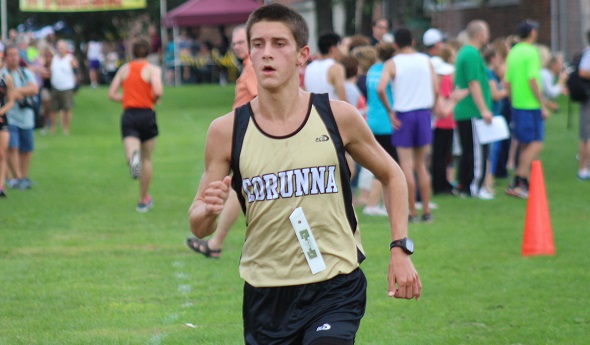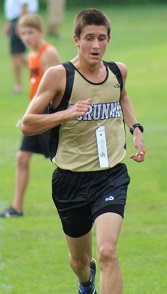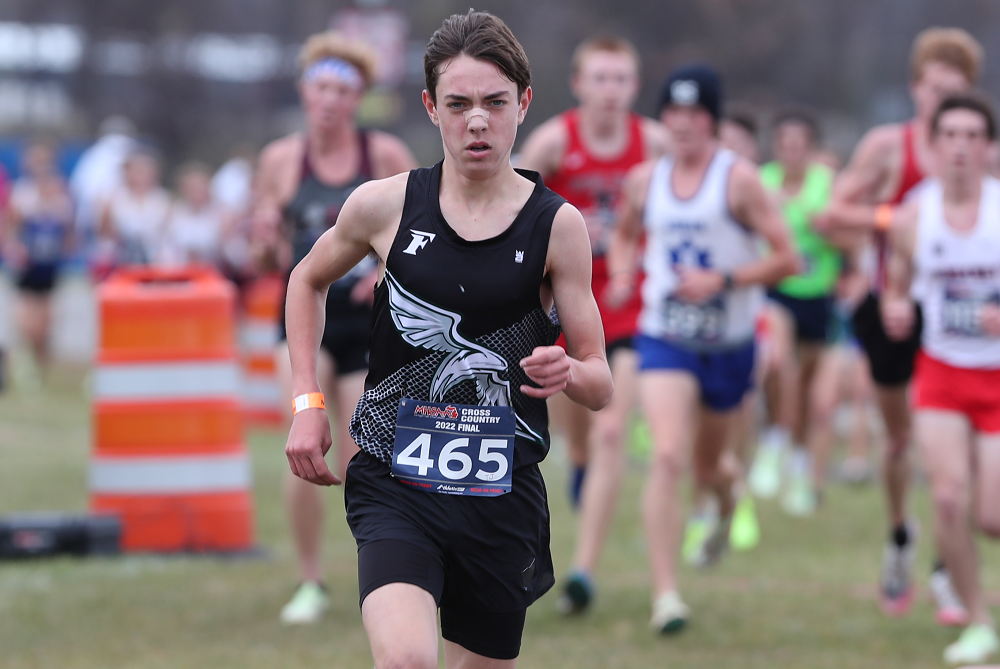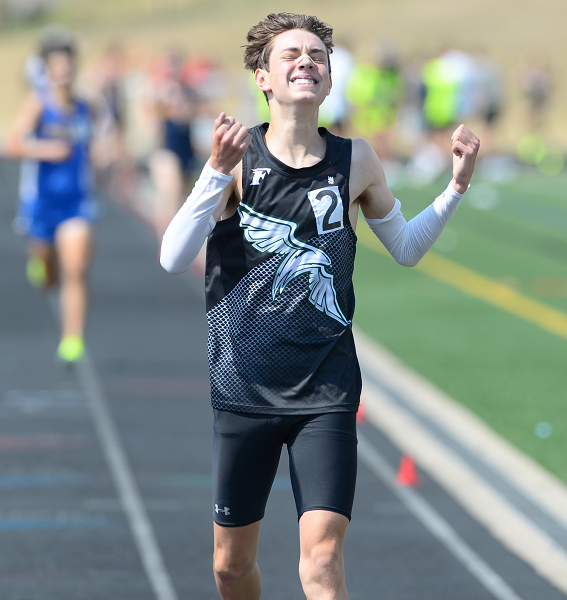
Performance: Corunna's Noah Jacobs
September 8, 2016
 Noah Jacobs
Noah Jacobs
Corunna senior – Cross Country
Jacobs is considered the state’s preeminent high school distance runner by many heading into this, his final season. He was runner-up at last year’s MHSAA Lower Peninsula Division 2 Final with a time of 15:30.5, which was ninth-fastest in any division and third among non-seniors, and he’s also the two-time reigning LPD2 champ in the 3,200 and set a meet record in the spring with a time of 8:55.57. Jacobs earned the first Michigan National Guard “Performance of the Week” of this school year after clocking a 15:43 to win the Medium Schools race at the annual Corunna Earlybird Invitaitonal while outpacing all runners at the event by at least 55 seconds.
Jacobs holds Corunna’s cross country record of 14:59.5, which he ran at the Portage Invitational last season in finishing second to now-graduated Algonac standout Morgan Beadlescomb – who also finished ahead of Jacobs at the MHSAA Final. Jacobs did win the Greater Lansing and Greater Flint meets and his Regional, and gained additional individual acclaim over the summer by winning the 2-mile championship at the New Balance outdoor national meet with a time of 9:03.71. Even with a bright future guaranteed, he has continued to set lofty high school goals, including leading his cross country team to its first MHSAA team championship since 1997. The Cavaliers finished fifth in LP Division 2 last season, and five of the team’s top seven from that race return. They also are getting an additional boost from Noah’s sophomore brother Ben, who is already coming close to or surpassing Noah’s personal records at that age. Noah Jacobs also should continue to drop his school record time this fall, as he’s running faster than at this point a year ago.
 In addition to his running excellence, Jacobs carries a 3.98 unweighted grade-point average (4.12 weighted) to rank among the top few in his graduating class. He’s considering University of Michigan, Michigan State, Notre Dame, Wisconsin and Stanford and careers in business or statistics after his running days at Corunna are complete.
In addition to his running excellence, Jacobs carries a 3.98 unweighted grade-point average (4.12 weighted) to rank among the top few in his graduating class. He’s considering University of Michigan, Michigan State, Notre Dame, Wisconsin and Stanford and careers in business or statistics after his running days at Corunna are complete.
Coach Bryan Heid said: “Noah has run every day since the summer before his freshman year. He also encourages others to do the same and to believe that they can do things they would otherwise not even dream of. He sets incredibly high goals and then goes out and puts those words into action. He is patient and sticks with the process. Every year he gets better and better because he does not try to skip steps. … If you want to understand what makes him a great leader, watch him after he crosses the finish line of a race. He knows that his race is not done until all of his teammates have finished. You will see him back out on the course cheering for the guys in the race he just ran with everything he had. Somehow he finds more and encourages the rest of our guys to give their best as well. Personal records are great, but team success is what truly drives him and causes him to celebrate. When our team has a great race, he is on top of the world even if his individual race did not meet his goals.”
Performance Point: “I was pretty happy with that (Earlybird time)," Jacobs said. "I wanted to run just a little bit faster, but I didn’t fully empty my tank. I ran a controlled race, didn’t try to overdo it at any point; I stayed comfortable but pushed it. … I wanted to go out and lead our group of guys; hopefully as a team we can chase a state title as well. I showed everybody that I’m still fit and I didn’t back off even though I’ve accomplished some of my goals.”
Big finish: “I have two big goals this season; the first is the win a team state title, and the second is to break the state record Dathan Ritzenhein has (14:10.4 for Rockford at the 2000 Finals). We’re into the part of the season where there’s a lot of training, and there are a couple races where it won’t show up and people won’t see it and question where I’m at. But once I get (there), in October, I’ll be ready to run really fast. … This is my fourth year doing the same general type of (training). I know what it’s like at this point in the season. It gets kinda hard, but at the same point, I know I’m going to see the benefit of what I’m doing now.”
High school matters: “It’s everything to me, that I can still do this for one more year, help out all the guys who helped push me through the years, and carry on the legacy of the guys who helped me when I was younger. Still represent my school and community in a good way, still be the change in athletics in Corunna, trying to lead the way for the generation of guys who are working really hard to be successful.”
 Brother’s catching up: “I see everything he does. I know how he works, really well, what works for him and what doesn’t. Everything we do for the most part is together, and it’s great to have him chasing all of my records because he’s going to work for it. But it’s also great for me because I have to have that edge in the sibling rivalry when we go to family reunions in 10 years. (So) I’ve gotta make him work for it; nothing's going to be easy for him.”
Brother’s catching up: “I see everything he does. I know how he works, really well, what works for him and what doesn’t. Everything we do for the most part is together, and it’s great to have him chasing all of my records because he’s going to work for it. But it’s also great for me because I have to have that edge in the sibling rivalry when we go to family reunions in 10 years. (So) I’ve gotta make him work for it; nothing's going to be easy for him.”
Getting down to business: “My dad is a business guy, and he owns a small business and has been successful and given us a good life – when we need a pair of running shoes, it’s not a problem, and we’re able to eat out once in a while. I would like to be at that same point when I’m that age where I can support my family well. And statistics, I’m a big numbers guy. During cross season I look at us, I look at other teams and where we stack up. Our cross coach was our stats teacher when I had it, and he made it interesting, and I saw all the difference fields you can go into.”
– Geoff Kimmerly, Second Half editor
Every week during the 2016-17 school year, Second Half and the Michigan National Guard will recognize a “Performance of the Week" from among the MHSAA's 750 member high schools.
The Michigan Army National Guard provides trained and ready forces in support of the National Military Strategy, and responds as needed to state, local, and regional emergencies to ensure peace, order, and public safety. The Guard adds value to our communities through continuous interaction. National Guard soldiers are part of the local community. Guardsmen typically train one weekend per month and two weeks in the summer. This training maintains readiness when needed, be it either to defend our nation's freedom or protect lives and property of Michigan citizens during a local natural disaster.
PHOTOS: (Top) Corunna's Noah Jacobs leads the pack during the Corunna Earlybird Invitational. (Middle) Jacobs paces the field alone during the Medium Schools race. (Photos courtesy of the Corunna athletic department.)

Freeland's Hansen Not Focused on Joining All-Time Greats - But On His Way
By
Paul Costanzo
Special for MHSAA.com
September 29, 2023
The goal written on Matt Kaczor’s Post-It Note was sub-15 minutes, 15 seconds. That’s what the Freeland cross country coach was hoping for from star runner TJ Hansen during his junior season.
 Kaczor tore it up after seeing Hansen run a single race this fall.
Kaczor tore it up after seeing Hansen run a single race this fall.
“Knowing what he did over the summer and where he was at, seeing what his 1,600 (meter) and his mile got down to, I had a feeling he could get under 15:30 quickly,” Kaczor said. “After the first race, I looked at my assistant and was like, ‘I’ve gotta rip up that Post-It Note. I don’t think our goal is on the level of where he’s at right now.’ At first, it was break 15:15. Once I saw him race at the Under the Lights (on Aug. 18 at St. Johns), I was like, ‘Yeah, he’s going sub 15.’”
Hansen ran 15:39.6 in that first race, and on Sept. 7, in Shepherd, he ran 15:13.9 to meet the goal written on the now-shredded Post-It Note.
This past Saturday, he ran 15:03.7 at the Cadillac Veterans Serving Veterans Invitational. It’s the fastest time recorded in Michigan this year, and a signal that Kaczor might be filling out a new Post-It Note before the season is out.
“The sub-15 barrier, that’s been something on my mind for a while,” Hansen said. “Now that I’m edging closer and closer to that, it’s been exciting. With how heavy my training has been, I wouldn’t expect (to have run this fast this early). Being able to run the times I am really paints the picture for what’s ahead.”
Hansen came into the season already regarded as one of the elite distance runners in the state. He won the 3,200 meters at the MHSAA Lower Peninsula Division 2 Track & Field Finals this past spring. He’s also finished all-state (12th and fifth, respectively) the past two seasons at the LPD2 Cross Country Finals.
His current trajectory, however, would put his name near some of the state’s all-time greats. But that’s not something Hansen is focusing on.
“I really don’t like to compare myself to others,” he said. “I don’t focus on that. I try to be the best TJ Hansen that I can be. The best version of myself.”
Focusing on himself is almost necessary for Hansen, as he’s spending a lot of time during his races running by himself.
At each of the big events Freeland has run in this season, Hansen has finished at least 20 seconds ahead of his nearest competitor. That includes all divisions of the Duane Raffin Festival of Races in Holly.
In Cadillac, where Hansen ran his current best time, he was a full minute ahead of the rest of the field.
 “He’s just a special athlete,” Kaczor said. “I can’t see Freeland having someone like this in a while. He’s a generational talent. What’s crazy is, I had the school record when he was a freshman. He and Braden (Honsinger) broke it last year. But TJ has now dropped that school record (set in 1998) by almost a minute.”
“He’s just a special athlete,” Kaczor said. “I can’t see Freeland having someone like this in a while. He’s a generational talent. What’s crazy is, I had the school record when he was a freshman. He and Braden (Honsinger) broke it last year. But TJ has now dropped that school record (set in 1998) by almost a minute.”
Hansen’s achievements have already put him on a path to run at the next level, which is something of a family tradition.
His older sisters Peyton and Kiera are track & field athletes at Wayne State and Eastern Michigan, respectively. Their parents, Tim and Pam, were track & field stars at Central Michigan.
TJ has drawn the attention of coaches around the country, including from Michigan, Michigan State, Wisconsin, Tennessee and Colorado.
Having family members who know the process is a help for Hansen, and he said they’ve all been good about allowing him to choose his own path, whatever that may be.
“He’s from a good family that knows how to work and knows how to get things done,” Kaczor said. “He knows that if he puts in the work, he’s going to be at a good spot.”
While Hansen admits it can be a bit overwhelming, he’s using it as motivation to run faster and continue to put his name out there.
Also serving as motivation is 2022 Division 2 champion Connell Alford of Chelsea. Alford is among the elite group of runners in Michigan who have broken the 15-minute mark, doing it twice a year ago.
He currently has the state’s second-best time behind Hansen’s this year, running 15:09.1 at the MSU Invitational on Sept. 15.
“Whenever I see him drop a time, my main goal is to run faster,” Hansen said. “Whenever I see him run a good time, that motivates me to work hard.”
The two won’t see each other until the MHSAA Finals on Nov. 4 at Michigan International Speedway. It’s an opportunity Hansen is excited for, as it’s a chance to race and be pushed toward the lofty goals he’s set for himself. Kaczor is excited about it, too, even if it might mean having to replenish his supply of Post-Its.
“We don’t talk about winning the state title; we talk about making sure that we have great races on those days,” Kaczor said. “We can’t control how somebody else runs. It’s a matter of can we, if the weather is right and the course is in good condition, can we be one of the few guys that has run in the 14s on that course? That’s the goal. Put yourself in some great categories with those upper echelons and the greats of all-time.”
 Paul Costanzo served as a sportswriter at The Port Huron Times Herald from 2006-15, including three years as lead sportswriter, and prior to that as sports editor at the Hillsdale Daily News from 2005-06. He can be reached at [email protected] with story ideas for Genesee, Lapeer, St. Clair, Sanilac, Huron, Tuscola, Saginaw, Bay, Arenac, Midland and Gladwin counties.
Paul Costanzo served as a sportswriter at The Port Huron Times Herald from 2006-15, including three years as lead sportswriter, and prior to that as sports editor at the Hillsdale Daily News from 2005-06. He can be reached at [email protected] with story ideas for Genesee, Lapeer, St. Clair, Sanilac, Huron, Tuscola, Saginaw, Bay, Arenac, Midland and Gladwin counties.
PHOTOS (Top) Freeland's TJ Hansen leads a pack during last season's LPD2 Final at Michigan International Speedway. (Middle) Hansen enjoys a moment of exhilaration after winning the 3,200 this spring at the LPD2 Finals at Ada Forest Hills Eastern. (Top photo by Carter Sherline/Run Michigan; middle photo by Dave McCauley/Run Michigan.)

